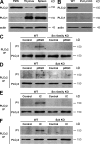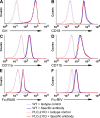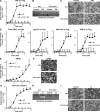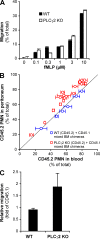Critical role of phospholipase Cgamma2 in integrin and Fc receptor-mediated neutrophil functions and the effector phase of autoimmune arthritis
- PMID: 19273622
- PMCID: PMC2699137
- DOI: 10.1084/jem.20081859
Critical role of phospholipase Cgamma2 in integrin and Fc receptor-mediated neutrophil functions and the effector phase of autoimmune arthritis
Abstract
beta(2) integrins and Fcgamma receptors are critically involved in neutrophil activation at the site of inflammation. Both receptor types trigger a receptor-proximal tyrosine phosphorylation cascade through Src family kinases and Syk, but further downstream signaling events are poorly understood. We show that phospholipase C (PLC) gamma2 is phosphorylated downstream of Src family kinases and Syk during integrin or Fc receptor-mediated activation of neutrophils. PLCgamma2(-/-) neutrophils are completely defective in beta(2) integrin or Fcgamma receptor-mediated functional responses such as respiratory burst, degranulation, or cell spreading in vitro and show reduced adhesion/spreading in inflamed capillary venules in vivo. However, PLCgamma2(-/-) neutrophils respond normally to various other agonists, including chemokines, bacterial formyl peptides, Toll-like receptor ligands, or proinflammatory cytokines, and migrate normally both in vitro and in vivo. To confirm the in vivo relevance of these observations, the effect of the PLCgamma2(-/-) mutation was tested in the K/BxN serum transfer arthritis model, which is known to require beta(2) integrins, Fcgamma receptors, and neutrophils. PLCgamma2 deficiency completely protected mice from clinical signs and histological features of arthritis as well as from arthritis-induced loss of articular function. These results identify PLCgamma2 as a critical player of integrin and Fc receptor-mediated neutrophil functions and the neutrophil-mediated effector phase of autoimmune arthritis.
Figures








Similar articles
-
Vav/Phospholipase Cgamma2-mediated control of a neutrophil-dependent murine model of rheumatoid arthritis.Arthritis Rheum. 2008 Sep;58(9):2712-22. doi: 10.1002/art.23757. Arthritis Rheum. 2008. PMID: 18759305 Free PMC article.
-
Tyrosine kinase Btk regulates E-selectin-mediated integrin activation and neutrophil recruitment by controlling phospholipase C (PLC) gamma2 and PI3Kgamma pathways.Blood. 2010 Apr 15;115(15):3118-27. doi: 10.1182/blood-2009-11-254185. Epub 2010 Feb 18. Blood. 2010. PMID: 20167705 Free PMC article.
-
The Vav binding site of the non-receptor tyrosine kinase Syk at Tyr 348 is critical for beta2 integrin (CD11/CD18)-mediated neutrophil migration.Blood. 2006 Dec 1;108(12):3919-27. doi: 10.1182/blood-2005-12-030387. Epub 2006 Aug 1. Blood. 2006. PMID: 16882714
-
Reprint of Neutrophil cell surface receptors and their intracellular signal transduction pathways.Int Immunopharmacol. 2013 Dec;17(4):1185-97. doi: 10.1016/j.intimp.2013.11.010. Epub 2013 Nov 18. Int Immunopharmacol. 2013. PMID: 24263067 Review.
-
Neutrophil cell surface receptors and their intracellular signal transduction pathways.Int Immunopharmacol. 2013 Nov;17(3):638-50. doi: 10.1016/j.intimp.2013.06.034. Epub 2013 Aug 30. Int Immunopharmacol. 2013. PMID: 23994464 Free PMC article. Review.
Cited by
-
L-selectin shedding affects bacterial clearance in the lung: a new regulatory pathway for integrin outside-in signaling.Blood. 2019 Oct 24;134(17):1445-1457. doi: 10.1182/blood.2019000685. Blood. 2019. PMID: 31366620 Free PMC article.
-
Calcium signalling and related ion channels in neutrophil recruitment and function.Eur J Clin Invest. 2018 Nov;48 Suppl 2(Suppl 2):e12964. doi: 10.1111/eci.12964. Epub 2018 Jun 22. Eur J Clin Invest. 2018. PMID: 29873837 Free PMC article. Review.
-
Lack of Galanin 3 Receptor Aggravates Murine Autoimmune Arthritis.J Mol Neurosci. 2016 Jun;59(2):260-9. doi: 10.1007/s12031-016-0732-9. Epub 2016 Mar 3. J Mol Neurosci. 2016. PMID: 26941032 Free PMC article.
-
Myeloid Src-family kinases are critical for neutrophil-mediated autoinflammation in gout and motheaten models.J Exp Med. 2023 Jul 3;220(7):e20221010. doi: 10.1084/jem.20221010. Epub 2023 Apr 19. J Exp Med. 2023. PMID: 37074415 Free PMC article.
-
Syk facilitates phagosome-lysosome fusion by regulating actin-remodeling in complement-mediated phagocytosis.Sci Rep. 2020 Dec 16;10(1):22086. doi: 10.1038/s41598-020-79156-7. Sci Rep. 2020. PMID: 33328565 Free PMC article.
References
-
- Nathan C. 2006. Neutrophils and immunity: challenges and opportunities.Nat. Rev. Immunol. 6:173–182 - PubMed
-
- Weiss S.J. 1989. Tissue destruction by neutrophils.N. Engl. J. Med. 320:365–376 - PubMed
-
- Eyles J.L., Roberts A.W., Metcalf D., Wicks I.P. 2006. Granulocyte colony-stimulating factor and neutrophils - forgotten mediators of inflammatory disease.Nat. Clin. Pract. Rheumatol. 2:500–510 - PubMed
-
- Nathan C. 2002. Points of control in inflammation.Nature. 420:846–852 - PubMed
-
- Witko-Sarsat V., Rieu P., Descamps-Latscha B., Lesavre P., Halbwachs-Mecarelli L. 2000. Neutrophils: molecules, functions and pathophysiological aspects.Lab. Invest. 80:617–653 - PubMed
Publication types
MeSH terms
Substances
Grants and funding
LinkOut - more resources
Full Text Sources
Other Literature Sources
Medical
Molecular Biology Databases
Miscellaneous

